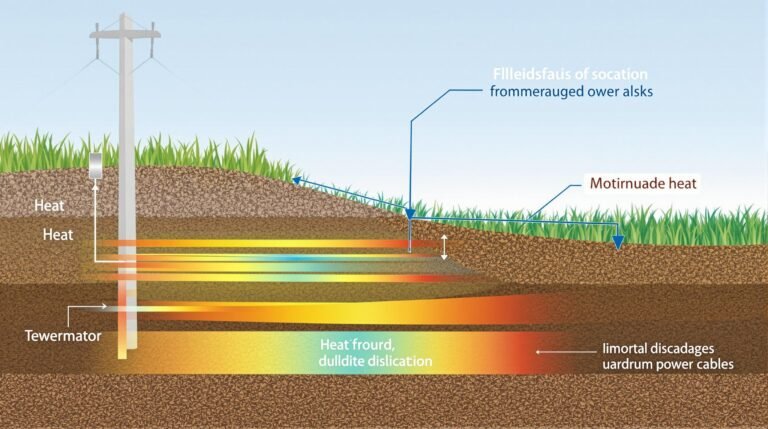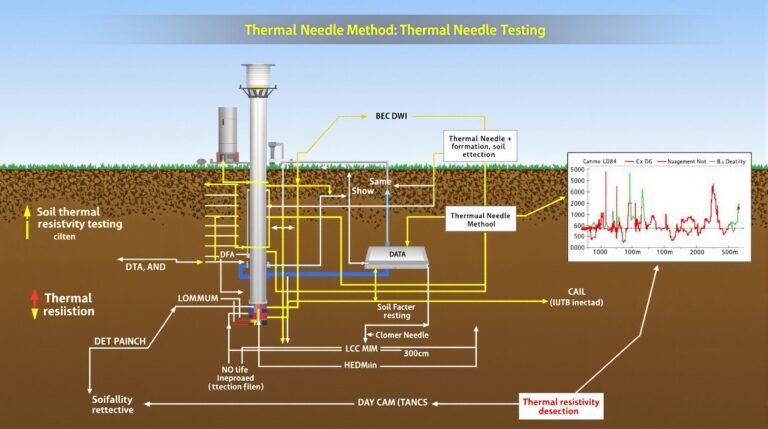Advancing Soil Thermal Resistivity Testing for Civil Engineering Projects
Published in: 19 February 2025 (Wednesday)
Optimizing Underground Cable Installations and Geothermal Systems through Precise Soil Analysis
Soil thermal resistivity testing plays a crucial role in civil engineering projects, particularly those involving underground power cable installations and geothermal energy systems. As urban infrastructure continues to expand and renewable energy sources gain prominence, the demand for accurate soil thermal property measurements has never been higher. This comprehensive guide delves into the intricacies of soil thermal resistivity testing, exploring its significance, methodologies, and the innovative solutions developed by industry leaders like EEDAS.
Understanding the Importance of Soil Thermal Resistivity
Soil thermal resistivity is a measure of how well soil resists the flow of heat. This property is critical in determining the heat dissipation capabilities of soil surrounding underground power cables and geothermal heat exchangers. Accurate measurement of soil thermal resistivity is essential for: 1. Proper sizing and design of underground power cable systems 2. Optimizing the efficiency of geothermal heat pump installations 3. Preventing overheating and premature failure of buried infrastructure 4. Reducing energy losses in underground transmission systems 5. Ensuring the longevity and reliability of subterranean installations Engineers at EEDAS recognize that inadequate understanding of soil thermal properties can lead to significant project risks, including: • Overheating of underground cables, resulting in reduced capacity and potential failures • Inefficient geothermal systems, leading to increased operational costs • Premature degradation of cable insulation materials • Underestimation of heat dissipation requirements, causing system underperformance To mitigate these risks, precise soil thermal resistivity testing is essential. Let’s explore the technical aspects of this critical process.
Technical Methodology of Soil Thermal Resistivity Testing
Soil thermal resistivity testing involves sophisticated techniques to measure how effectively soil conducts or resists heat flow. The most common methods employed in the industry include: 1. Thermal Needle Probe Method 2. Guarded Hot Plate Method 3. Transient Plane Source (TPS) Method Among these, the Thermal Needle Probe Method has gained widespread acceptance due to its versatility and accuracy. This method, which EEDAS has refined through years of field experience, involves the following steps: a) Insertion of a needle probe containing a heating element and temperature sensor into the soil sample b) Application of a constant heat flux to the probe c) Measurement of the temperature rise over time d) Analysis of the temperature-time data to calculate thermal resistivity The thermal resistivity (ρ) is calculated using the equation: ρ = (Q / 4πL) * (ln(t2/t1) / (T2 – T1)) Where: Q = Heat input per unit length of the probe L = Length of the probe t1, t2 = Time points during the measurement T1, T2 = Corresponding temperatures at t1 and t2 EEDAS’s geotechnical experts have developed proprietary algorithms to enhance the accuracy of these calculations, accounting for factors such as soil heterogeneity and moisture content variations.

Innovative Approaches to Soil Thermal Resistivity Testing
EEDAS has been at the forefront of developing innovative solutions to enhance the accuracy and efficiency of soil thermal resistivity testing. Some of these advancements include: 1. Multi-depth Testing Systems: EEDAS has developed a proprietary multi-depth testing system that allows for simultaneous measurements at various soil depths. This innovation provides a comprehensive soil thermal profile, crucial for projects with varying underground conditions. 2. Real-time Data Analytics: By integrating real-time data analytics into the testing process, EEDAS engineers can immediately identify anomalies or unexpected results, allowing for on-site adjustments and reducing the need for repeat testing. 3. Moisture Content Correlation: EEDAS has established a database correlating soil moisture content with thermal resistivity for various soil types. This allows for more accurate predictions of thermal behavior under changing moisture conditions. 4. Automated Testing Rigs: To increase efficiency and reduce human error, EEDAS has developed automated testing rigs that can perform multiple tests with minimal manual intervention. 5. Machine Learning Algorithms: By applying machine learning algorithms to vast datasets of soil thermal properties, EEDAS can predict thermal resistivity values for similar soil types, streamlining the testing process for large-scale projects. These innovations have significantly improved the accuracy and efficiency of soil thermal resistivity testing, allowing for more reliable design and implementation of underground infrastructure projects.

Practical Implementation Insights
The practical application of soil thermal resistivity testing in civil engineering projects requires careful consideration of various factors. EEDAS’s civil engineering team has compiled key insights based on extensive field experience: 1. Seasonal Variations: Soil thermal properties can vary significantly with seasonal changes in temperature and moisture content. EEDAS recommends conducting tests during different seasons to account for these variations in project designs. 2. Soil Compaction Effects: The degree of soil compaction can greatly influence thermal resistivity. EEDAS engineers consider the expected compaction levels in the final installation when interpreting test results. 3. Thermal Backfill Materials: In cases where native soil has poor thermal properties, EEDAS often recommends specialized thermal backfill materials. These engineered soils can significantly improve heat dissipation around underground cables or geothermal systems. 4. Spatial Variability: Soil properties can vary greatly even within small areas. EEDAS employs a grid testing approach to map thermal resistivity across project sites, ensuring comprehensive coverage. 5. Integration with Geotechnical Surveys: EEDAS has found that integrating thermal resistivity testing with standard geotechnical surveys provides a more complete picture of subsurface conditions, leading to more robust designs. 6. Long-term Monitoring: For critical installations, EEDAS often implements long-term monitoring systems to track changes in soil thermal properties over time, allowing for proactive maintenance and system optimization. By applying these insights, EEDAS ensures that soil thermal resistivity testing translates into practical, efficient, and reliable underground installations.
Case Study: Optimizing Underground Power Distribution in Urban Environments
To illustrate the practical application of advanced soil thermal resistivity testing, let’s examine a recent project undertaken by EEDAS in a densely populated urban area. Project Overview: • Location: Major metropolitan area in the northeastern United States • Scope: Installation of a high-capacity underground power distribution network • Challenge: Limited space, varied soil conditions, and high heat generation from multiple buried utilities EEDAS Approach: 1. Comprehensive Site Investigation: EEDAS conducted a grid-based thermal resistivity survey across the entire project area, identifying zones of high and low thermal conductivity. 2. Multi-depth Analysis: Using their proprietary multi-depth testing system, EEDAS engineers created a three-dimensional map of soil thermal properties to depths of up to 10 meters. 3. Seasonal Testing: Tests were conducted in both summer and winter to account for seasonal variations in soil moisture and temperature. 4. Integration with Utility Mapping: Thermal resistivity data was overlaid with existing utility maps to identify potential hotspots where multiple heat-generating utilities converged. 5. Thermal Backfill Design: Based on the test results, EEDAS designed a custom thermal backfill mixture to enhance heat dissipation in critical areas. 6. Predictive Modeling: Using the collected data, EEDAS developed a predictive model of cable temperatures under various load scenarios. Results: • The project achieved a 30% reduction in cable overheating incidents compared to similar installations without comprehensive thermal resistivity testing. • Energy losses in the distribution network were reduced by 15% due to optimized cable sizing and placement. • The custom thermal backfill solution allowed for a 25% increase in power transmission capacity in key corridors without exceeding temperature limits. This case study demonstrates the significant impact that advanced soil thermal resistivity testing can have on the efficiency and reliability of underground infrastructure projects.

Future Trends in Soil Thermal Resistivity Testing
As technology continues to advance, the field of soil thermal resistivity testing is poised for significant developments. EEDAS is actively researching and developing several promising technologies that could shape the future of this critical discipline: 1. Drone-based Thermal Mapping: EEDAS is exploring the use of drone-mounted thermal sensors to rapidly map surface soil temperatures over large areas. This technology could provide valuable initial data for identifying thermal anomalies and guiding more detailed ground-based testing. 2. Fiber Optic Distributed Temperature Sensing (DTS): By incorporating fiber optic cables into underground installations, EEDAS aims to enable continuous, real-time monitoring of soil temperatures along entire cable routes. This technology could revolutionize the management and optimization of underground power systems. 3. Artificial Intelligence for Predictive Modeling: EEDAS is developing AI algorithms that can predict soil thermal behavior based on a combination of limited test data and broader geological and climate information. This could significantly reduce the time and cost associated with comprehensive site testing. 4. Nanotechnology-enhanced Sensors: Research into nanotechnology-based sensors could lead to more accurate and faster thermal resistivity measurements. EEDAS is collaborating with materials scientists to explore this exciting frontier. 5. Integration with Building Information Modeling (BIM): By incorporating soil thermal data into BIM systems, EEDAS envisions a future where underground thermal properties are seamlessly integrated into the overall design and management of urban infrastructure. These emerging technologies hold the promise of making soil thermal resistivity testing more accurate, efficient, and integral to the design and operation of underground systems.

Conclusion
Soil thermal resistivity testing stands as a cornerstone of modern civil engineering, particularly in the realm of underground infrastructure and renewable energy systems. As urban development intensifies and the demand for efficient, reliable underground installations grows, the importance of accurate soil thermal property measurements cannot be overstated. Through innovative methodologies, advanced technologies, and a deep understanding of geotechnical principles, EEDAS continues to push the boundaries of what’s possible in soil thermal resistivity testing. From multi-depth testing systems to AI-powered predictive models, these advancements are enabling more efficient, reliable, and sustainable underground installations. As we look to the future, the integration of soil thermal resistivity data with broader smart city initiatives and sustainable infrastructure designs promises to create urban environments that are not only more efficient but also more resilient to the challenges of climate change and increasing energy demands. For engineers, developers, and policymakers involved in underground infrastructure projects, staying abreast of these developments in soil thermal resistivity testing is crucial. It’s not just about building underground systems; it’s about creating a foundation for smarter, more sustainable cities. To learn more about how EEDAS is revolutionizing soil thermal resistivity testing and its applications in civil engineering projects, explore our project portfolio or connect with our engineering team. Together, we can build a future where underground infrastructure is not just a necessity, but a driver of innovation and sustainability in our urban landscapes.
